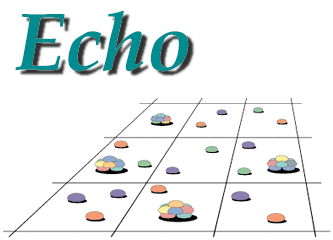
Outline
What is Echo?
Echo is a simulation tool developed to investigate mechanisms which
regulate diversity and information-processing in systems comprised of
many interacting adaptive agents, or complex adaptive systems (CAS).
Echo agents interact via combat, trade and mating and develop
strategies to ensure survival in resource-limited environments.
Individual genotypes encode rules for interactions. In a typical
simulation, populations of these genomes evolve interaction networks
which regulate the flow of resources. Resulting networks resemble
species communities in ecological systems. Flexibly defined
parameters and initial conditions enable researchers to conduct a
range of "what-if" experiments.
This figure illustrates the
hierarchical organization of the Echo world. Resources, which are
represented as letters (a,b,c,d), constitute the agents' genomes.
Agents can forage for resources, interact with one another, and
self-reproduce when they have sufficient resources to copy their
genome, all within a particular site. A site is analogous to a
chemostat; a world is comprised of one or more sites. Agents
migrate among sites when they cannot find resources.
If you would like to run a Java version of Echo by Hans Woppman, visit here.
More detailed descriptions are available in
Refs. 1-4.
The Source Code
Please note that this implementation is not now being maintained.
Further, no graphical user interface is available for the current
version. However, many options to log variables at specified
intervals have been provided.
Please do not send us mail asking how to compile earlier
Echo versions. The widgets will not compile and earlier
versions are not being supported.
The current version is 1.3 beta 2. The existing implementation of
Echo runs on most UNIX and LINUX systems. Click here to ftp the
tarred, compressed distribution.
Terry Jones wrote a document to describe how to use this
implementation. It details how to compile and install the C source
code, and walks the user through an example run. Unfortunately, it is
a bit outdated and only describes version 1.1. Click here to ftp the
compressed postscript file [Ref. 4], or click here to view the HTML
version.
Ginger Booth and Oswald Schmitz revised Echo to study trophic
cascades in a three species (tritrophic) food web. Their
implementation is called Gecko. Click here to
learn more about Gecko.
Publications
- Forrest, S. and T. Jones. 1994. Modeling complex adaptive systems with Echo. pp. 3-21 in R.J. Stonier and X.H. Yu, eds. Complex Systems: Mechanisms of Adaptation. IOS Press, Amsterdam. (Click here to download the gzipped postscript file.)
- Schmitz, O.J. and G. Booth. 1996. Modeling food web complexity: The consequence of individual-based spatially explicit behavioral ecology on trophic interactions. Evolutionary Ecology 11:379-398. (Click here to view the HTML version of their paper.)
- Hraber, P.T., T. Jones and S. Forrest. 1997. The ecology of Echo. Artificial Life 3(3):165-190. (Click here for the pdf file.)
- Hraber, P.T. and B.T. Milne. 1997. Community Assembly in a Model Ecosystem. Ecological Modelling 103:267-285. (Click here for a gzipped postscript file or here to view the abstract.)
People Involved
- Following is an incomplete list of people involved in research and development of Echo:
- Original concept and implementation:
- John Holland (Univ. of Michigan & Santa Fe Institute)
- Terry Jones (then at Santa Fe Institute)
- Echo researchers include:
- Other participants at the 1995 Echo workshop, and interested parties:
- Julian Adams (Univ. of Michigan)
- Jim Brown (Univ. of New Mexico)
- Marcus Feldman (Stanford University)
- Jim Levenick (Willamette University)
- Dan McShea (then at Santa Fe Institute)
- Bruce Milne (Univ. of New Mexico)
- Rick Riolo (Univ. of Michigan)
- Michael Cohen (Univ. of Michigan)
References
- Forrest, S. and T. Jones. 1994. Modeling complex adaptive
systems with Echo. pp. 3--21 in R.J. Stonier and X.H. Yu, eds.
Complex Systems: Mechanisms of Adaptation. IOS Press, Amsterdam.
- Holland, J.H. 1994. Echoing emergence: Objectives, rough
definitions, and speculations for Echo--class models. in G.A. Cowan,
D. Pines and D. Meltzer, eds. Complexity: Metaphors, Models and
Reality. Addison--Wesley, Reading, MA.
- Holland, J.H. 1996. Echoing emergence: Objectives, rough
definitions, and speculations for Echo--class models. in G.A. Cowan,
D. Pines and D. Meltzer, eds. Complexity: Metaphors, Models and
Reality. Addison--Wesley, Reading, MA.
- Jones, T. and S. Forrest. 1993. An Introduction to SFI Echo.
Technical Report 93-12-074, Santa Fe Institute, Santa Fe NM.
Available via anonymous ftp from
ftp.santafe.edu:pub/echo/how-to.ps.Z.
What's New
- 10/16/98. Added link to Hans' Java implementation, general updates.
- 05/05/97. Added link to Hraber & Milne paper.
- 07/23/96. Fixed links to the ftpable Echo source.
- 02/19/96. Added the Echo graphic at the top of the page, re-organised the list of people involved.
- 10/30/95. Changed ftp link to download Version 1.2, rather than 1.1.
- 09/20/95. Fixed ftp link to download Version 1.1, rather than 1.0.
- 09/15/95. Added diagram and description of hierarchical organization of world. Document moved to a new location.
- 07/24/95. Added links to home pages and Schmitz and Booth's Gecko work.
- 04/27/95. Version 1.1 is now being distributed and contains fixes for problems with migration and crossover code.
Compiled by Peter Hraber and Simon Fraser. Last revised 10/16/98.
